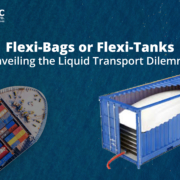Flexitanks vs. Flexibags: Understanding the Pros and Cons
Choosing the right liquid transport container for seamless delivery of your liquid goods.
In the dynamic world of liquid transport, choosing the right container can make a significant impact on efficiency, cost, and environmental footprint. Fluid Flexitanks, a leading provider of innovative liquid transport solutions, understands this intricate dance. Today, we delve into the often-confused world of flexibags and flexitanks, highlighting their key differences and helping you with the optimal choice for your specific needs.
What are Flexibags?
Flexi-bags, sometimes called bulk bags or pillow tanks, are essentially large, single-use plastic bags designed for temporary storage or low-volume transport of non-hazardous liquids. Made from sturdy yet relatively thin layers of polyethylene, they offer affordability and easy disposal. However, their lightweight construction compromises their durability and they’re not suitable for long-distance transport of hazardous materials.
What are Flexitanks?
Flexitanks, on the other hand, are robust, multi-layered containers built with reinforced materials like food-grade polyethylene and polypropylene. These tanks are specifically designed for safe and secure bulk liquid transport within standard shipping containers. They offer numerous advantages over flexi-bags, including:
- Increased Durability: Engineered for the rigors of international shipping, our flexi-tanks withstand pressure and punctures much better than flexi-bags.
- Enhanced Security: Multiple layers and specialized fittings minimize leakage risks and ensure product integrity.
- Higher Volume Capacity: Flexitank can hold significantly larger volumes (up to 24,000 litres) compared to flexibags, maximizing container utilization and reducing transport costs.
- Wider Application: We offer a variety of flexitank options suitable for transporting non-hazardous and even some hazardous liquids, depending on UN regulations.
- Sustainability: While disposable, our flexitanks are recyclable, minimizing environmental impact.
Choosing the Right Option: It’s All About Your Needs
Here’s a quick comparison to help you decide:
| Feature | Flexibags | Flexitanks |
| Durability | Lower | High |
| Capacity | Lower | High |
| Security | Less secure | Enhanced security |
| Suitability | Non-hazardous, low-volume transport | Non-hazardous, some hazardous, high-volume transport |
| Cost per litre | Potentially lower | Higher |
| Sustainability | Recyclable | Recyclable |
When are Flexibags Suitable?
- Short-term storage of non-hazardous liquids
- One-time, low-volume transport within regional areas
- Cost-sensitive applications where durability and security are less critical
When are Fluid Flexitanks the Better Choice?
- Long-distance, international bulk liquid transport
- Transport of hazardous or high-value liquids requiring enhanced security
- Situations where maximizing container space and minimizing transport costs are crucial
- Adherence to stricter environmental regulations
Why choose Fluid Flexitanks
At Fluid Flexitanks, we understand that every project has unique requirements. Our team of experts is here to help you choose the right solution for your specific needs. From providing comprehensive consultations to offering various flexitank options and sizes, we ensure you have an efficient and secure solution for your bulk liquid transport.
Get in touch with us today to discuss your specific needs and discover how Fluid Flexitanks can streamline your operations and deliver peace of mind.


